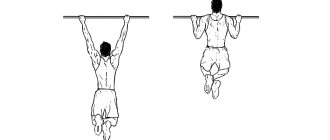Gaining muscle mass is the dream of gym beginners. Quickly increasing the required volume, becoming stronger, more defined and looking better is a worthy goal. But it is difficult to say the exact time of its achievement. Human bodies are subject to many genetic and physiological laws. We all lead different lifestyles, and have characteristics of diet, food absorption, training regimen and rest. But people keep asking how long it takes to actually get big, how much you can gain, and where the limit is for muscle growth. Let's try to understand this issue.
Answers to questions: more important than you think
If you know scientifically based answers to questions about the speed of muscle pumping, you can get rid of illusions and make fewer mistakes in the process of working on yourself. Inflated expectations in the gym are the cause of injury, disappointment, and premature transition to anabolic steroid use. We read articles that tell how this or that actor gained 12 kg of lean muscle in 3 months, and we think that at lower speeds we shouldn’t even hope for adequate results in the gym.
It’s good if a beginner simply continues to learn the technique of basic exercises and lament that, unfortunately, he is not Wolverine. What if he starts buying useless supplements for muscle growth, purchasing diets from “Instagram gurus,” and eating everything from gainers to grandma’s cottage cheese with jam. What will he get in the end? Stomach upset at best. Excess fat, and problems with the liver and kidneys, at worst. Useless supplements siphon off a lot of money, a person begins to think that the gym is for the rich, and, as a result, he lies down on his favorite sofa again. This does not improve health, and self-esteem collapses.
For girls it's even more difficult. They dream of having rounded buttocks, toned hips, and beautifully drawn lines of the back and shoulders, but they do not want to look like professional bodybuilding athletes, for the most part. Many truly believe that huge “male-type” muscles are built not from a combination of heavy training, anabolic steroids, and a certain diet, but simply from the very fact of doing squats, deadlifts, and bench presses. That’s why the fitness industry offers a new “muscle tightening” program every day. As a result, many hours that could be spent effectively in the gym are spent on yet another nonsense, which, at best, strengthens the cardiovascular system, and at worst, simply increases appetite without providing incentives for muscle growth.
Knowing the actual rates of muscle growth eliminates wasted time and money, and simplifies the task for the psyche.
Getting pumped up in 2 months: is it realistic?
Main conclusions
To swing properly in the gym, you need to follow these recommendations:
- Choose a training program based on your goals and body type.
- Combine basic, isolation exercises, as well as cardio.
- Train your entire body evenly.
- Exercise no more than 3 times a week with breaks of 2 days.
- Hone your technique, and then gradually increase the load.
- Don't forget to warm up and cool down to avoid injury.
- Change your training program regularly.
- Eat right.
- Take sports nutrition only after consulting a specialist.
By following these rules, you can achieve impressive results in just 3 months. The muscles will become more voluminous, stronger, and the body will become more prominent.
How much muscle mass can you really gain?
Gaining muscle mass is not a priority subject for research by medical scientists. Today there are only a few scientifically based positions on this topic. A fairly well-known experiment by Arthur Jones showed that a healthy man without the use of anabolic steroids and subject to adequate nutrition, recovery and heavy training in failure can gain no more than 8 kg of muscle in a training cycle of 12 weeks. We were talking about initially strong and athletic people who were not overweight.
Biologists say that in a lifetime you can gain:
- Approximately 22 kg if you are a man;
- About 12 kg if a woman.
Why do professional bodybuilders deny this? The answer is simple - anabolic steroids. They accelerate protein synthesis, allowing you to increase volume and weight beyond what nature intended for a particular person. But you need to understand that the use of such substances has side effects for both men and women, and is not justified for health and fitness purposes.
There are other data - in a week, with an ideally structured regime, a man can add about 100 g of muscle mass, a woman - about 50 g. Sometimes they say that the maximum gain for men over a 12-week training cycle is about 6 kg, for women - 2 -3 kg, which means total body weight, not just muscles.
Important: weight gain can be more significant, since with excess nutrition, not only muscle mass grows, but also a person’s fat layer.
Of course, there are exceptions to the rules. Average values are valid for the so-called average genetic endowment. There are people who can gain more and faster, and those who can gain less. Usually, insignificant gains are compensated by the fact that a person practically does not add fat. Therefore, ectomorphs can be lean and sculpted with less muscle, while endomorphs can spend significant effort on reducing body fat, but still look “damp.”
What are basic exercises: purpose, advantages, rules
Many athletes do not know that it is not at all necessary to constantly complicate the exercises, as well as increase the load beyond their strength. If muscle mass is growing steadily, then there is no need to overwork. It is enough to perform a basic set of exercises. Sometimes this option is the only one available, for example, when there is sorely not enough time for full-fledged intense strength training. In such cases, this very basic program that we will present to you will help out.
The basic exercises in the gym for men are exercises that do not concentrate on anything specific. They are aimed at uniformly working several muscle groups at once.
The main purpose
When figuring out what kind of exercises these are, it doesn’t hurt to first find out what they are designed for, and most importantly, who and why they are best suited.
- Basic movements teach how to contract muscles correctly, gradually and consistently building up the muscle foundation. This is good news for beginners in the gym, because the correct execution of the exercises is what they need to think about first.
- For experienced athletes, they will become a kind of rest from grueling training and will allow you to maintain periodization (from light to heavy).
- Not all athletes consider sport a way of life; many consider it just a hobby. Basic exercises will allow them to practice without going too deep into the process, while still getting good results.
- By performing these simple movements, people belonging to different types can build muscle mass: mesomorphs and ecomorphs.
Even for those who have not yet fully learned to listen to their body, such a base will come in handy. Not only boys, but also girls take part in such programs; you shouldn’t discount them.
Advantages
Basic training in the gym for men has a number of advantages, without which it would be impossible to appreciate the full weight of such exercises.
We recommend reading: Fitness trends 2020
- Thanks to such activities, there is a noticeable acceleration of metabolism. This will help in quickly losing weight and maintaining normal body weight.
- Multi-joint exercises, which are included in the basic set, help to significantly increase strength, endurance, agility, and at the same time stimulate proper muscle growth.
- The whole body is worked out evenly, thanks to clearly calibrated, correctly selected exercises.
In addition, scientists have proven that by doing basic exercises, we stimulate the secretion of growth hormone and testosterone, which in turn are directly aimed at muscle growth. That is, anabolic hormones are produced faster and in greater quantities during such training.
Rules for exercising in the gym
The exercises included in the basic set help not only build beautiful, sculpted muscles, but also eliminate excess subcutaneous fat. They are quite complex and require a lot of energy expenditure from the athlete. Therefore, it is recommended to include it in the training program for everyone. However, before you start selecting options, it won’t hurt to familiarize yourself with the simple rules of training in the gym.
- Any workout, especially a basic one, must, unconditionally, begin with a warm-up. You can simply walk on a treadmill at medium power for about ten minutes or do a few bodyweight exercises. All this is aimed at warming up the muscles, which helps avoid injury during exercise.
- For beginners, immediately after warming up, starting the base, you can limit yourself to 1-3 exercises. It is not forbidden to make a few more insulating ones. This will be quite enough. More advanced athletes can regulate the load, number and time of training themselves.
- Don't chase quantity, this is the wrong tactic. It is better to concentrate on the correctness and clarity of the movements. The technique is very important, if it is not followed you can easily get serious injury.
It’s best to end your workouts in the gym with a special cool-down. You can do some stretching exercises at the same time. All this will reduce the intensity of lactic acid secretion, so the pain the next morning will not be so acute.
How long does it take to actually get pumped up?
So, we found out the maximum rates of muscle mass gain. At what speed can you gain muscle in reality?
- Average for men: from 100 to 200 grams of muscle per week (this is about 0.5-1 kilogram per month);
- Average for men: from 50 to 100 grams of muscle per week (this is about 200-500 grams per month).
Does such a set occur in reality? Usually people gain more or less. There are many factors - diet style, amount of salt in the diet, macronutrient ratio, quantity and quality of carbohydrates. In addition, weight is affected by stress levels, hormonal fluctuations in women, medications, and even a common cold.
Sometimes people cannot gain an ounce simply because they are exposed to work and family stress, and stress increases calorie expenditure. Some people suffer from lack of sleep, while others suffer from sleep quality. Therefore, calculating weight gain in advance is quite a difficult job.
In strength sports, usually an 8-12 week cycle allows a novice athlete to add 3-5 kg of weight, taking into account the fact that he monitors nutrition. But the training differs significantly from bodybuilding - a large amount of work in basic exercises and a relatively small amount in auxiliary exercises. It is also significant that before a competition a strongman can lose 2-3 kg of “water” weight, when the microtraumas of the muscles heal and the muscles stop holding weight. This well-known effect allows you to plan weight categories. And fitness beginners can judge the actual weight gain and its speed.
How long does it take to pump up? The main secret.
If I go to the gym, will I lose weight?
It all depends on what you want. You can lose weight if you don’t eat, but lose weight along with your muscles without ever achieving the shape you want. To achieve your goals, you need to build a diet and exercise routine, and monitor your sleep patterns. Many people don’t understand this when they come to the gym: they train, go away on the weekend, and start again on Monday. You need to competently rebuild your body, and not run away from the gym a month after starting training with the words “I can’t do anything!”
Functional training
There are times when you need to increase the level of functionality. For example, prepare for entrance exams to a university (military, police school, physical education universities) or for an upcoming hiking trip to the mountains.
This requires the development of several motor qualities - strength, endurance, flexibility and coordination. As a rule, this takes from 2 to 6 months of regular classes.
If a girl leads an active lifestyle and is “friendly” with sports, 2 months is enough. If the body is not prepared, it will take about 6 months.











